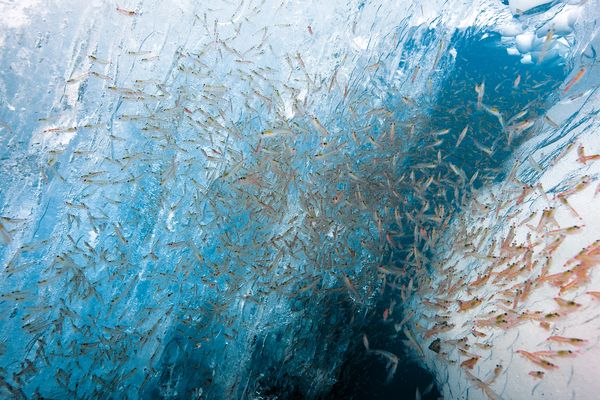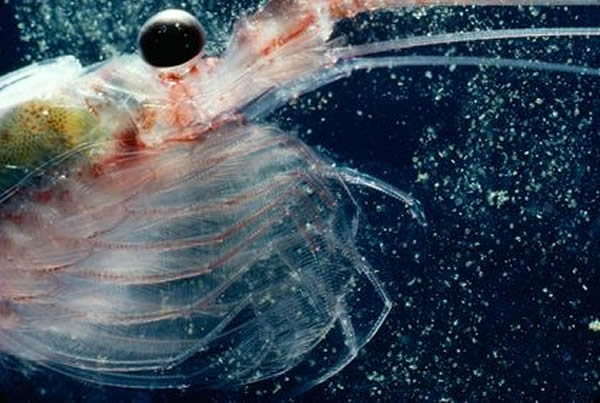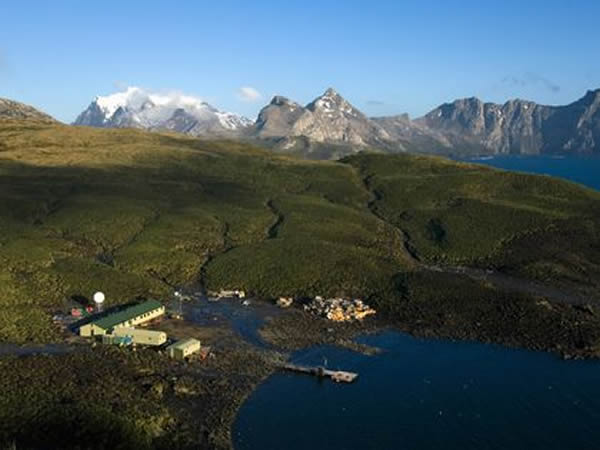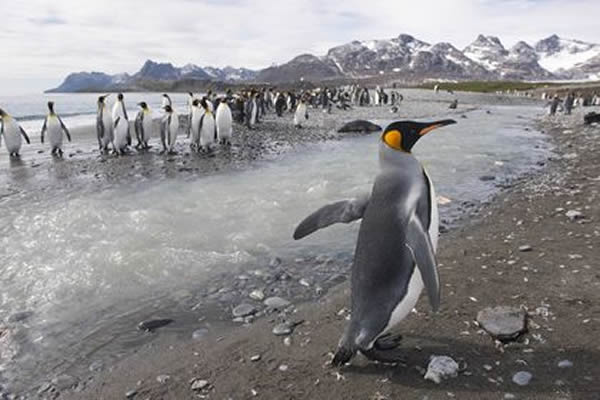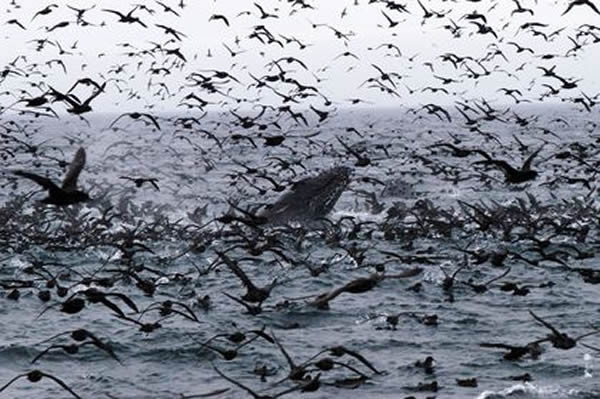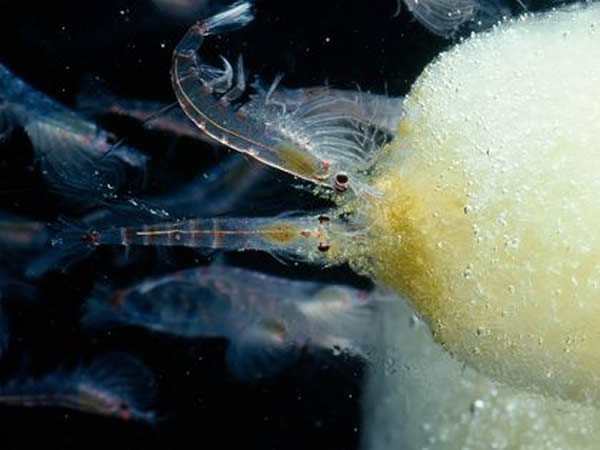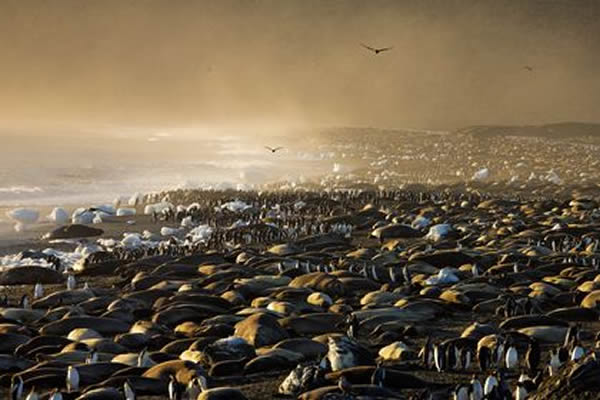Life in Antarctica Relies on Shrinking Supply of Krill
Krill feeds on phytoplankton that grows on the underside of sea ice on South Georgia Island off Antarctica.
On the Antarctic island of South Georgia, in February, toward the middle of what passes for summer at the bottom of the world, I hurried through the ruined whaling station of Grytviken.
I had an appointment at the British Antarctic Survey station on the opposite side of King Edward Cove. I was to interview a marine ecologist working on krill. I did not want to be late.
The keystone of the South Georgia ecosystem, the secret to the miraculous abundance of wildlife on this stark, cold, windswept island—the foundation, indeed, for almost all vertebrate life in the Antarctic—is krill.
South Georgia and the South Sandwich Islands are administered from the Falkland Islands as a British Overseas Territory, in which the little outpost of Grytviken is the only inhabited spot. The inhabitation is very marginal. In southern winter there are just eight staff members of the British Antarctic Survey, including a doctor, a government officer, and a postal clerk. A handful of visiting scientists augment this skeleton crew in southern summer.
Grytviken is gritty and grim. The name means "Pot Bay," a reference to the cauldrons in which the Norwegian whalers here rendered oil from blubber. It is apt. The rusting vats, boilers, ramps, chimneys, and ramshackle buildings of the long-abandoned whaling station; the wrecks of the catcher boats stranded on the waterfront; and the rows of giant whale-oil tanks upslope are all the apparatus of a genocide, in the literal, Latin sense of the word. The genus was Balaenoptera, the baleen whale.
From the whale's upper jaw, in place of teeth, hang long, fringed curtains of keratin—baleen—used to seine krill. The largest member of the genus and the biggest creature ever to live, the blue whale gets that way from its ability to process eight tons of krill a day.
The Antarctic, in its remoteness, girded by pack ice, abloom in summer with phytoplankton and coursing with torrents of krill, was the stronghold of the blue whale. The invention of the steam-powered catcher boat and the explosive harpoon ended all that. Today in the Southern Ocean, where a century ago 200,000 blue whales fed on the krill swarms of austral summer, only a few hundred are left.
A Game of Chinese Boxes
If William Blake thought he had seen "dark satanic mills" in England, then he should have taken a stroll through Grytviken. After the darkness of the whaling station, and the black, snow-seamed rock of the encircling mountains, and the somber sky, the white interior of the British Antarctic Survey laboratory was dazzling.
For a moment I lost my bearings. Bright fluorescent light glinted from microscopes. Martin Collins turned away on a swivel stool from his laboratory workbench and stood to greet me. In his immaculate white lab coat he was incandescent, an angelic figure of medium height, pale-skinned, with semi-curly hair of indeterminate color. This might have been the start of the Rapture, with Collins as my heavenly guide—until I chanced to glance down. Beneath his white lab coat the ecologist was wearing muddy trousers and gumboots streaked with penguin guano.
He mimed an apology for not shaking hands, holding up both of his own to show blue rubber gloves. Just now he had been rooting around in fish stomachs. Pulling over a bucket of offal, he groped about inside and extracted a half-digested mackerel icefish. "That's come out of a skate's stomach," he said.
"A little worse for wear," I suggested.
Collins agreed and he dug again in the offal, searching for a more intact specimen. His bucket of guts was bloody, but not in the normal, crimson sense, for icefish have no hemoglobin. Their plasma is full of antifreeze but no red cells, so their blood runs clear.
"This one's probably slightly better," he said, holding up a less eroded fish. "There's a fishery for these mackerel icefish. We've done a trawl survey for icefish all around South Georgia to estimate the stocks. Icefish are krill feeders—80 percent of their diet is normally krill—so their stomachs can tell us what's happening with krill. I've done something like 650 icefish in the last couple of weeks. It's been a slightly strange year for the krill around South Georgia."
"Strange," I said. "In what way?"
"You get odd years, and 2004 was one of those, when there's a little bit less krill. This year seems to be fairly extreme. There's very little krill and scarcely any icefish at all. We're seeing the gentoo penguins struggling a little bit this season, as well. Not enough krill. The gentoos don't seem to be giving the food to their chicks that they normally do."
From his workbench Collins retrieved a glass dish of krill. He had extracted this handful—eight or nine little shrimplike crustaceans—from the stomach of an icefish, which he had previously extracted from the stomach of a skate, and had counted, weighed, and measured each one.
In death the krill were bright red. They were big Euphausia superba, the king of krill, probably the most successful species on Earth by measure of sheer biomass: roughly twice the weight of humanity, thronging in "swarms" as dense as 10,000 individuals per cubic meter.
In Norwegian, kril means "small fry." The noun is almost always a collective plural in that language, as it is in English. And as it is in the grammar of Nature herself, where krill are collective like no other organism. The name has an onomatopoeic rightness; "krill" seems to boil, seethe, swarm.
Collins's game of Chinese boxes—his opening of stomachs to investigate the stomachs within—had ended with this dish of krill. No further dissection was necessary, for krill are translucent, and the green contents of the gastric mill and the hepatopancreas were visible through the exoskeleton. In the middle of krill mating season, the last meal—interrupted by a hungry icefish—for these krill had been phytoplankton.
A krill shrimp traps tiny plants with its thoracic legs off Antarctica.
The Thrill for Krill
Euphausia superba breeds in Antarctic summer, January through March, in dense spawning aggregations near the ocean surface. On the abdominal segment of the males, the first pair of "swimming legs" (technically called pleopods or swimmerets) are modified into sex organs with handlike appendages, the gonopods. For krill, ejaculation is replaced by gesticulation. Working deftly with his gonopods, the male attaches a kind of limpet mine—the spermatophore, or sperm package—to the female. The thrill for krill must be something like the clandestine excitement a Navy frogman feels in setting up a demolition.
The female's eggs, between 5,000 and 10,000 per session, are fertilized by sperm from the spermatophore as they exit her genital opening. The fertilized eggs sink slowly, sometimes as deep as two miles, and during the descent they develop into embryos. At depth, each egg hatches into a larva—the nauplius—which begins to make its way back up.
The nauplius is a little cyclops, just a head with three pairs of sculling appendages where ears might go and a single compound eye. In a "developmental ascent," the nauplii, transmogrifying as they rise, spend three weeks or so reaching the top, where they appear in vast numbers just under the surface.
There is something almost Hindu in the ontogeny of krill: Each little crustacean, in growing up, shape-shifts through a progression of avatars. After the nauplius comes the metanauplius, then the three stages of the calyptopis, then the six stages of the furcilia—a succession of incarnations in which the thorax and abdomen separate and differentiate, the legs multiply and develop. The single eye divides in two (depth perception, suddenly!), and this new pair of compound eyes, fixed at first, becomes moveable and erupts from the carapace, rising on short stalks above. At a little more than a half-inch in length, the juvenile becomes a miniature of the adult. At two inches in length and three years of age, it reaches maturity.
In a species whose strategy is to overwhelm with sheer numbers, it is surprising, perhaps, that each individual Euphausia superba should be such a careful, exquisite piece of work. Each one looks to have been delicately carved from translucent, rose-tinted crystal. Each one is cunningly organized on the Swiss Army knife principle, with an ingenious set of glassy tools folding out from its underside: the squad of swimming and breeding legs on the abdomen (pleopods and gonopods), the squad of feeding and grooming legs on the thorax (the thoracopods), an assortment of sensory and feeding appendages on the head (antennae, antennules, stalked eyes, and mandibles), and a tail-fan (telson) at the stern.
Scientists study marine life from Bird Island BAS Research Base on South Georgia Island.
Survival Strategies
In a species so small and expendable—just fodder for a whole ecosystem of sea mammals, seabirds, cephalopods, and fish—it is remarkable that the individuals should live as long as they do, from five to ten years. To escape all the hungry mouths in the sea and live out that full span, krill resort to a bagful of survival tricks, detailed below.
Lobstering. As a rule, euphausiid krill proceed headfirst, rowing forward with coordinated strokes of their swimming legs, like little oars in Roman galleys, but in emergencies the tail-fan of the telson provides a powerful reverse gear. In a fright response that short-circuits the brain (such as it is) and is mediated entirely by giant neurons in the tail, the krill snaps its telson violently to send itself "lobstering" backward at two feet per second, in a nearly instantaneous escape reaction.
Luminescence. Euphausiid krill are sometimes called "light shrimp" for their bioluminescence. From photophores at the base of their legs and eye-stalks, they emit pulses of yellow-green light. The krill do not themselves manufacture the luciferin that fuels this luminescence; they sequester it instead from the phosphorescent dinoflagellates they eat. This pirated luciferin migrates to the nearly heatless lamps of the krill's photophores, each of which has a concave reflector at the back, a lens in front to focus the beam, and muscles to swivel the spotlight this way and that.
We know how krill illuminate themselves—it's just the glow of a good meal—but we are uncertain as to why. The lights may help in orienting the swarm in darkness, or they may be used for signaling during spawning aggregations, or both. For the most part the photophores are on the underside. This has led some scientists to hypothesize that the lights are counter-illumination, a means of softening the silhouettes of the krill against daylight or moonlight above. From the vantage of predators below, according to this hypothesis, the krill's suit of lights works like an invisibility cloak.
Juvenescence. In hard winters when food is scarce, krill shed their sex organs and regress to a kind of juvenile form (the Peter Pan or Michael Jackson strategy). Everything shrinks but the protuberant compound eyes. We know this big-eyed hunger syndrome from images of human famine, but in krill the effect is even more pronounced. The ratio between eye size and body length has proved a reliable indicator of starvation in krill. The little crustaceans can survive 200 days without food. When summer arrives finally and the phytoplankton bloom, the krill regrow their sex organs and take up adult life again.
Countermeasures. When pursued, krill will sometimes spontaneously molt, leaving behind their exuvia—their shed exoskeletons—as decoys. The exuvium is a perfect facsimile of the little animal, down even to the fine, comblike "teeth" on the feeding legs, except that there is nothing inside. The ghost krill drift and spin behind the real ones like "chaff," those aluminum strips jettisoned as radar countermeasures by warplanes.
Filter-feeding. The prime adaptation of Euphausia superba, the explanation for its extraordinary biomassiveness, lies in its ability to feed directly on phytoplankton, particularly on the tiny single-celled plants called diatoms. Krill economic policy is to cut out the middleman and eat at the very bottom of the food pyramid.
The krill's foremost rank of legs, the thoracopods, are modified into feathery combs that it clasps together prayerfully to form a "feeding basket," which it pushes ahead through the sea. At intervals it unclasps the basket to comb the netted diatoms toward its mouth with bristles on the inner edges of its thoracopods.
Filter-feeding in this manner is more familiar to us on a much larger scale: This is how manta rays, basking sharks, whale sharks, and baleen whales feed. If the archetype for the factory ship is the blue whale, then the archetype for the blue whale is Euphausia superba, its principal prey. Any given blue whale is built by eating vast multitudes of these tiny crustacean approximations of itself.
King penguins on the beach at Salisbury Plain, Antarctica.
Trouble in the Nursery
When I had finished studying Collins's glass dish of krill, I returned it to him. He peered at it for a moment, tilting the dish at a steeper angle to the light, as if some new question about these specimens had just occurred to him. Then he dumped it unceremoniously into the bucket of fish offal. All the data he needed had been gleaned from this batch, and the contents of the bucket would now feed the skuas.
Science, Collins told me, was not yet able to say whether global warming had figured in this year's krill shortage.
"According to oceanographers back at Cambridge, about every fifth year you get a bad krill year," he said. He explained that South Georgia lies north of the zone of winter sea ice that serves krill as nursery. Krill swarms are brought up to South Georgia on a "conveyor belt" of cold current from the Antarctic Peninsula, and every five years or so the belt seems to go off track.
Early this year, the plume of krill appeared to swing too far west, then curl around north of South Georgia to join the eastward-flowing mainstream of the Antarctic Circumpolar Current. Large specimens, like the ones he had consigned to the bucket, are characteristic of poor krill years, Collins said. Because the younger krill normally borne up on the plume had missed the island, the few krill showing up now in the stomachs of icefish were bigger, older holdovers from previous years.
"There is some evidence for a global-warming effect," he added. "In 2004 a colleague of mine—name is Angus Atkinson—published research based on a long series of standardized net-hauls for krill. He did show that there's evidence of a decline in the amount of krill in the last 40 years around here in the Scotia Sea. I think the jury is still out a little bit on that."
Having read this paper, published in Nature, myself, I was puzzled by Collins's last comment. His scientific caution was admirable, but it crossed my mind that there might be some wishfulness there, and some denial. As I understood it, the jury had, at very least, filed back into the courtroom and was studiously avoiding the eyes of the defendant.
Humpback whales and shearwaters feast on abundant krill.
Less Ice Means Fewer Krill
Atkinson and his three co-authors had conducted the most comprehensive study yet of krill abundance and distribution in the Southern Ocean, gathering data from all the net samples they could find over the previous 80 years, a total of 12,000 summer net-hauls. This database showed that the southwest Atlantic sector of the Southern Ocean—the narrow, productive stretch between the Antarctic Peninsula and South Africa—contained more than half the krill in the Southern Ocean. It also indicated that krill stocks in this crucial sector had declined by 80 percent in the previous 30 years.
The study did not directly identify the cause of the decline, but it provided a hint: Summer krill densities in the southwest Atlantic correlate positively with sea-ice extent the previous winter.
Antarctic sea ice typically expands fivefold in the course of a year. At its winter maximum, it often covers eight million square miles, nearly twice the area of the Antarctic continent and eight percent of the entire Southern Hemisphere. This vast substrate of ice—or superstrate, actually, as it forms the frozen ceiling of the ocean—is colonized by ice algae, which green the brine channels in the ice and the undersides of drifting floes.
Krill, with rows of rakelike bristles at the tips of their thoracopods, scrape the algae from the ice and pass it on to their mandibles. The vast extent of these filmy krill pastures, their bioenergetic potential, and their crucial role in sustaining the Antarctic ecosystem through the winter months have only recently been incorporated in scientific models. This adjustment comes even as science has begun to quantify how rapidly, in response to climate change, the sea ice is diminishing at both poles, not only in extent but in duration.
"Krill are dependent on the sea ice in winter," Collins said. "The juvenile krill in particular feed under the sea ice, and some of the adult krill as well. Declines in sea ice associated with warming means less habitat for krill and, therefore, in the longer term, certainly less krill. I do think we're looking at that sort of thing potentially, in the middle to long term. I think Atkinson's work suggests that decline is already beginning to happen."
Penguin distribution on the Antarctic Peninsula is shifting with this new reality. The Adélie penguin, a true Antarctic penguin, is sea-ice obligate, which is to say that it requires sea ice to survive. The chinstrap penguin, a more northerly species, is sea-ice intolerant. As the western Antarctic Peninsula warms, Adélie penguin populations there are declining sharply and chinstrap populations are growing. (There are similar perturbations among penguin species farther south in Antarctica. The new "march of the Penguins" is a kind of route step, disorderly and in several directions.)
Juvenile krill, like Adélie penguins, are sea-ice obligate. The nursery ice for the South Georgian krill plume is disappearing at the source.
Shrimp krill scrape algae growing on the underside of Antarctic ice.
Heart of the Antarctic
If krill is the staff of life for the baleen whales of the Southern Ocean—if these great animals are just so much recycled krill—then so it is for most Antarctic creatures. The crabeater seal has leaflike, multi-lobed teeth that intermesh to form a sieve for krill (the "crabs" of its name), and it eats almost nothing else. The Antarctic fur seal has cheek teeth with a similar shape and function, and it feeds primarily on krill.
The leopard seal, behind the great fangs of its canine teeth, has molars that fit together as krill sieves. (The sea leopard has a reputation for killing penguins and lesser seals with those canines, but in truth its great bulk—ten times that of the terrestrial leopard—is owed mostly to the sieves of its molars and the krill that make up a large part of its diet.)
Gentoo, Adélie, and emperor penguins are obligate feeders on krill. The Procellariiformes, the "tube-nose" birds that dominate the Antarctic avifauna—the albatrosses, petrels, prions, shearwaters, and fulmars—feed directly on krill or on things that eat krill.
The extirpation of baleen whales in the first half of the last century opened up the krill resource to these smaller krill-eaters. Penguins and petrels prospered. The crabeater seal multiplied prodigiously and now numbers from 15 to 30 million, the most abundant seal in the world. The Antarctic fur seal has made a sensational recovery: from putative extinction a little more than a century ago to about four million today, 90 percent of which breed on South Georgia. A rebound on this scale seems miraculous, mathematically impossible, until one factors in the infinitude of krill that fed the resurrection.
No natural system exists in a steady state. Polar ecosystems, which are characterized by large numbers of individuals and relatively few species, are particularly unstable, prone to cycles of boom and bust. In the past two centuries in the Antarctic, these steep swings in fortune have been sharply amplified by a new agency: us.
First the depredations of the Antarctic sealing fleets, then the depredations of the whalers, then the anti-depredation effects of the Antarctic Conservation Act, then heavy fishing pressure, and now climate change have intensified the booming and busting. Homo sapiens came very late to Antarctica—an American sealer named John Davis was the first human to set foot on the continent in 1821—but since then that foot has been on the scales, first nudging the bust side of the balance, then the boom side.
If the Antarctic ecosystem is seen as a heart, pumping its red streams of krill, then for the last century it has been a heart in fibrillation.
King penguins and elephant seals on the beach at St Andrews Bay.
Taking the Helm
Martin Collins pulled the blue rubber glove off his left hand and held it for a moment in his right, thinking of something. Then he took off the right glove. He surfaced from his thoughts and gave me a look.
"I'm changing jobs in a couple of weeks' time," he said. "I'm taking over as senior executive for South Georgia. I'll have overall responsibility for fisheries and tourism and everything else in the island."
In this new capacity, Collins would be reporting to the governor of the Falklands, up a chain of command ending with the Queen of England, but here within the Antarctic Convergence the buck—or the pound sterling—would stop with him.
"So this is going to be your domain!" I said.
"Yes." He laughed lightly, dismissively, but clearly he was pleased.
South Georgia is now well into its Collins administration. The senior executive and fisheries director is enjoying himself, according to his emails, but his responsibilities are legion and he finds himself very busy.
Just three months into his new job, Collins had to deal with an episode of counterfeiting. Someone in the Northern Hemisphere was turning out commemorative coins purporting to be licensed by the Government of South Georgia and the South Sandwich Islands (GSGSSI)—which is a long and fancy way of saying that they were supposedly licensed by Collins himself. Heads on these dubious coins showed an effigy of Queen Elizabeth II. Tails showed either images of the Horse Guards of London, the Tower of London, Westminster Abbey, or Windsor Castle. "The Government of South Georgia and the South Sandwich Islands wishes to state categorically that these Bi-Metallic pieces should be treated as fakes," Collins informed the world, from his office way down under.
Some months later, Collins, in his secondary role as fisheries director, issued an Administrative Penalty Notice to a longline vessel fishing under GSGSSI license in GSGSSI waters. The fishermen had failed to report the killing of two albatrosses. They had been caught discarding baited hooks, as well—a hazard to albatrosses and other seabirds. For the two dead albatrosses, Collins fined the mariners £25,000. It was the sort of stiff punishment for albatross abuse that you might find in a long narrative poem by Coleridge.
The sheer sweep of Collins's responsibility is daunting. He manages the whole northern rim of the Scotia Sea, the 1,500-mile stretch from Shag Rocks eastward to Bristol, the final and southernmost of the South Sandwich Islands.
Rolling in from all sides is the Southern Ocean, the wildest, windiest, most prolific seas on Earth. The South Georgia Maritime Zone extends 200 nautical miles outward from the island in all directions and is patrolled by Collins's navy, his jet boats Prion and Pipit and his flagship Pharos, an old Scottish lighthouse tender converted to Coast Guard cutter.
Kingdom of Krill
The main island, South Georgia, is one hundred miles long, steeply mountainous and glacier-carved into an endless coastline of deep bays and fiords. Four million Antarctic fur seals and 400,000 Southern elephant seals breed on the shores there. Smaller delegations of Weddell and crabeater seals haul out on the rocky South Georgian beaches, and leopard seals loll offshore in the kelp.
Thirty million pairs of burrowing petrels nest beneath the soil. More than 450,000 pairs of king penguins stand at attention in the bays and coves, shoulder to shoulder in endless black-and-white formations.
In the breeding season, the main island hosts nesting gentoo, macaroni, chinstrap, and rockhopper penguins. Wandering, black-browed, gray-headed, and light-mantled sooty albatrosses nest here, along with Southern giant petrels, Northern giant petrels, snowy sheathbills, and skuas.
If natural history is treasure—and zoologists always see it that way—Collins is now an Antarctic Croesus.
Out there in the screaming sixties, winging underwater, are all the penguin species that pass the island without nesting here—the emperor, royal, and Magellanic penguins. Winging above are all the airborne flocks that do the same: Southern royal, sooty, and Salvin's albatrosses; little, great, and sooty shearwaters; Antarctic, Atlantic, Kerguelen, white-headed, great-winged, and soft-plumaged petrels.
The maritime zone is Collins's specialty, home to the icefish, skates, squid, and Patagonian toothfish he knows so well, but home also to six species of baleen whale, all now designated "rare" or "scarce," and five species of beaked whale, not to mention sperm whales, killer whales, hourglass dolphins, and spectacled porpoises.
It is, all of it, an ecosystem fabricated out of krill.
These days I find myself thinking a good deal about Martin Collins, down there in the furious fifties, in the Antarctic Convergence. I have come to see him as symbolic. He is master now of his favorite place in the universe, a miraculously abundant island in cold seas. He is in mild denial, perhaps, about his island's prospects in the era of climate change. Or maybe he is just serene in acceptance of the things he cannot change. He is managing what is manageable within his 200-mile limit-keeping his eye on the Patagonian toothfish, chasing pirate fishing boats, addressing the outrage of counterfeit coins—even as the planet warms and the krill begin to fail ... which is to say he is every one of us.
Kenneth Brower
for National Geographic
Published August 17, 2013
